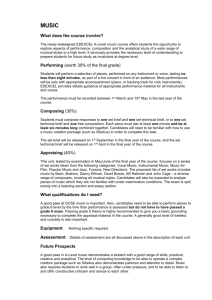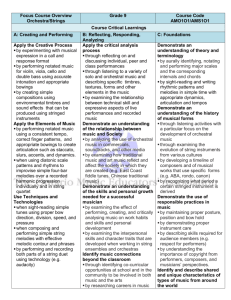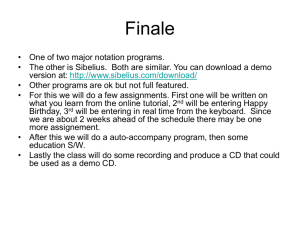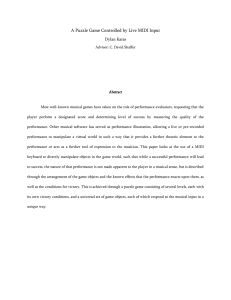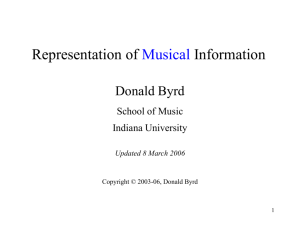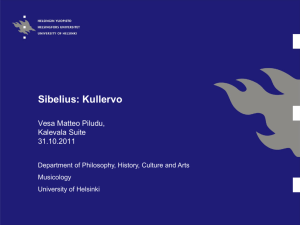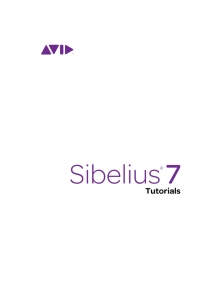Electronic Music - Niles Township High School District 219
advertisement
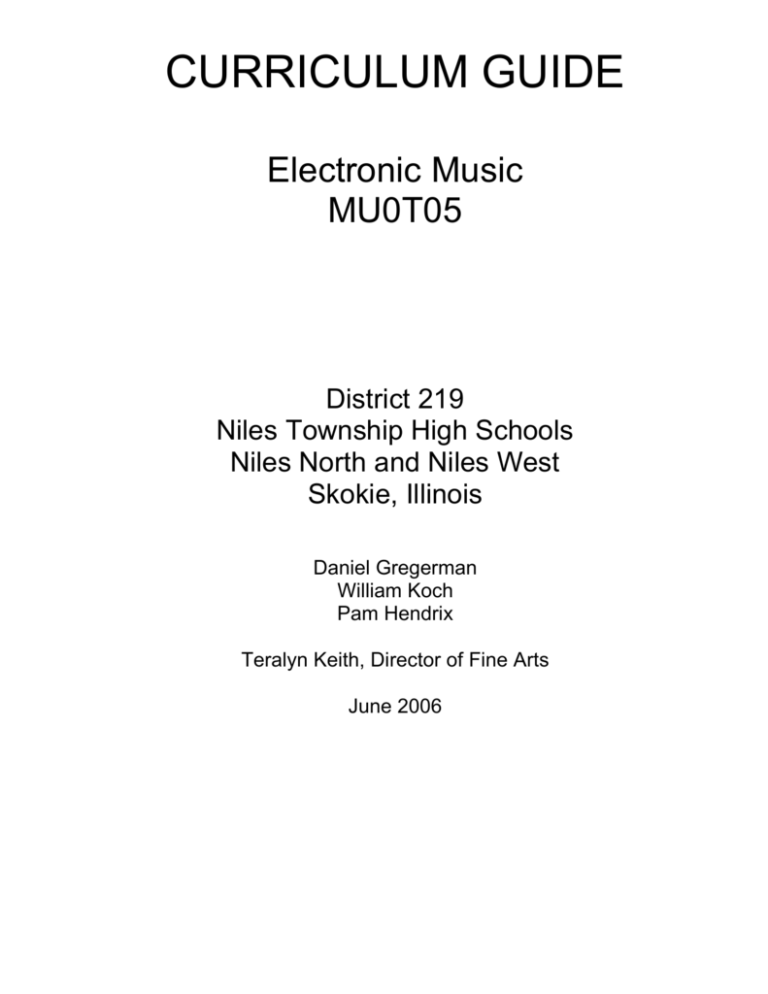
CURRICULUM GUIDE Electronic Music MU0T05 District 219 Niles Township High Schools Niles North and Niles West Skokie, Illinois Daniel Gregerman William Koch Pam Hendrix Teralyn Keith, Director of Fine Arts June 2006 Table of Contents Coursebook Description ..................................................................................[p. 3] Department Structure ......................................................................................[p. 4] Instructional Materials .....................................................................................[p. 5] Agreed Upon Elements ...................................................................................[p. 6] Units of Instruction with Student Learning Outcomes Coded to State Goals and/or Benchmarks ..............................[p. 7] Summative Assessment Description ...............................................................[p. 8] Unit of Instruction Examples ...................................................................... [p. 9-10] 2 Coursebook Description Electronic Music MU0T05 Length: 1 semester Credit: 1 credit Open to Grades: 10-12 Grade Weight: III Prerequisite: Digital Piano 1 or Consent of Instructor This course encompasses aspects of recording, producing, manipulating, and engineering music and sound. Students will use several different types of software and involves creating loops, sound design/sound systems, and working with the many different digital forms of music used today. Students will learn the basics of music notation, theory, form, and other musical elements, as well as study the many different types of media, such as e-mail, web pages, MP3s, WAV, AIIF, etc. 3 Department Structure MUSIC PROGRAM SEQUENCES Pathways illustrate typical movement with a sequence of courses. Grade Weight Level is indicated in parentheses. Band Beginning Band (III) Concert Band (III) Symphonic Band(III)* Symphonic Wind Ensemble (IV)* Philharmonic Orchestra (III)* Symphonic Orchestra (IV)* Chamber Choir (III)* Advanced Choir (IV)* Orchestra Beginning Orchestra (III) Concert Orchestra (III)* Choir Choraliers (III) Concert Choir (III)* Non-Performing Electives Guitar 1 (III) Guitar 2 (III) * Digital Piano 1 (III) Digital Piano 2 (III) * Electronic Music (III) * Music Theory (IV) * * Consent of teacher required 4 Instructional Materials Text Reason 3 Ignite! Pub: Thomson Course Technology PTR: Stacy L. Hiquet 2005 Supplemental Material Software Reason 3.0 Band-in-a-Box Garage Band Sibelius 4.0 5 Agreed-Upon Elements Agreed Upon Elements Mixing Drum Tracks Bass Lines Lead Lines (Melody) Harmonies Arranging Editing Loops Effects Sampling Sequencing Audio Routing Exporting Importing Composition Chord Entry Musical Styles (Rock, Jazz, R&B, Swing, etc.) Lead Line (Notated) Lyrics Production (CD, MP3, etc.) Notation Symbology Form Rhythm Note Reading Basics Music Theory Basics Texture Terminology & Application Music Industry Electronic Components 6 Skill Introduced X X X X X X X X X X X X X X X X X X X X X X X X X X X X X X Units of Instruction with Student Learning Outcomes Coded to State Goals and/or Benchmarks State Benchmark 25.B.5 26.A.4d, 5 26.B.4c, 5 27.A.4b 27.B.4a, 4b, 5 26.A.4d, 5 Unit TV Series Theme Music Unit Elements Students will produce 16-24 bars of music that can be used as an Intro. or as an Outro. for a new TV series. Importing/Printing Music in a Notation Program 26.A.4d, 5 Lead Sheet Creation 26.A.4d, 5 27.B.4a, 4b, 5 25,B.4 26.A.4d, 5 27.A.4a, 5 27.B.4a, 4b, 5 25.A.4, 5 26.A.4d, 5 26.B.4c 27.A.4b Musical Style Study Students will import a MIDI file, convert it to notation, edit, and print it out as a complete score with individual instrument parts. Students will use a selected piece of music and enter the melody and chord structure into the program Band-in-a-Box and save it as a MIDI file. Students will manipulate a predetermined MIDI file into different musical styles. Students will study the history of electronic music from the 1960s to the present. Electronic Music History Student Critique Students will formally listen, assess, and evaluate their work as well as the work of their peers. 7 Summative Assessment Description Students are given both written and individual performance assessments throughout the semester. 8 Unit of Instruction Example Electronic Music Title of Unit TV Series Theme Music Student Learning Outcomes • Students will produce 16-24 bars of music that can be used as an Intro or Outro for a new TV series. • Students will create their musical ideas inspired by a pre-existing vocabulary list. • Students will incorporate skills learned in Reason 3.0. • Students will demonstrate basic composition form and structure. • Students will critique their work and the work of their peers. Length or Timeline Two weeks Materials Used to Teach the Unit Reason 3.0 Internet usage Supplemental materials Class Activities Class discussion Use of class time Students sharing information Out-of-Class Assignments Drop in the lab for individual work Research Individualization Each student is responsible for his/her own project Unit Assessment The unit will be assessed in the following areas: structure/form, melody, chord sequence, drum patterns, loops, different sound incorporation, effects, organization, and does the student’s work fit the TV series theme? 9 Unit of Instruction Example Electronic Music Title of Unit Importing/printing music in a notation program Student Learning Outcomes • Students will import a MIDI file, convert it to notation, edit, and print it out as a complete score with individual parts Length or Timeline One week Materials Used to Teach the Unit Sibelius 4.0 Supplemental materials Using previously created material through Band-in-a-Box Class Activities Teacher demonstration Student manipulation of Sibelius and Band-in-a-Box programs Use of class time Out-of-Class Assignments Drop in the lab for individual work Individualization Each student is responsible for his/her own project Unit Assessment Students will turn in a score and a set of parts in a style of their own choice other than the original. The unit will be assessed on the score and set of parts having the correct format as listed in the following areas: title, composer, instrument, measure numbers, dynamics, rhythm accuracy, form, overall attention to detail, and organization. 10
